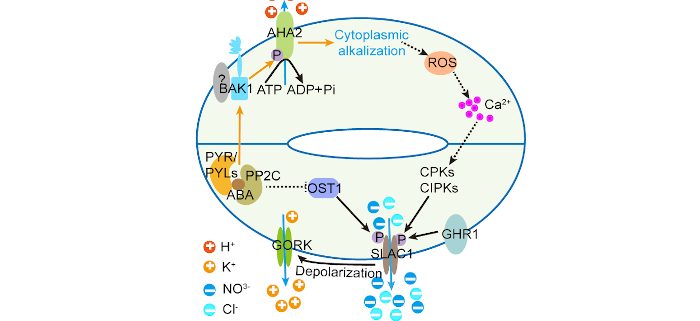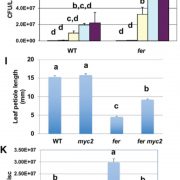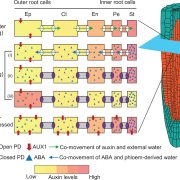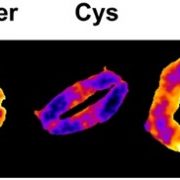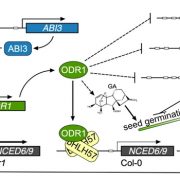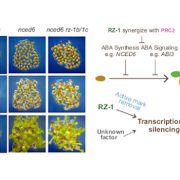AHA2 is involved in ABA-induced stomatal closure
Author et al. explore the role of plasma membrane H +-ATPases in ABA-induced stomatal closure.
https://doi.org/10.1093/plcell/koac106
By Zhizhong Gong1, 2 and Dan Pei1
1State Key Laboratory of Plant Physiology and Biochemistry, College of Biological Sciences, China Agricultural University, Beijing, 100193, China
2School of Life Sciences, Institute of Life Science and Green Development, Hebei University, Baoding, 071002, China.
Background: Stomatal opening and closure are modulated by different signaling pathways in plants. Blue and red light promote stomatal opening by activating plasma membrane (PM) proton H+-ATPases, mainly AHA1 and AHA2, through phosphorylating their C termini to promote proton efflux across the guard cells, thus activating the hyperpolarization-gated K+ channel KAT1 to open stomata. ABA induces stomatal closure through activating protein kinases such as OST1/SnRK2.6, GHR1 and CDPKs, which activate SLAC1 to transport chloride and nitrate out of guard cells, followed by K+, which results in stomatal closure.
Question: It is well known that PM H+ – ATPases play crucial roles in light-stimulated stomatal opening. However, it is unclear whether the PM H+-ATPases are also involved in ABA-induced stomatal closure.
Findings: The receptor-like protein kinase BAK1 plays an important role in ABA-induced stomatal closure. We identified in this study that BAK1 interacts with AHA2. Unexpectedly, we discovered that aha2 mutants are insensitive to ABA-promoted stomatal closure, but not impaired in the ABA-mediated inhibition of light-promoted stomatal opening. ABA-activated BAK1 phosphorylated AHA2 at Ser-944 in its C terminus to activate the H+-ATPase, which promoted a transient efflux of protons, cytoplasmic alkalinization and the accumulation of ROS in the guard cells to initiate ABA signal transduction and promote stomatal closure. Our findings enhance our understanding of the role of PM H+-ATPases in the early ABA-induced stomatal closure signaling events that take place in guard cells.
Next steps: Our study raises some interesting questions about the biological roles of PM H+-ATPases in both light-promoted stomatal opening and ABA-induced stomatal closure. Further studies should explore the mechanism by which pH triggers ROS production, whether pH and the ROS pathway have parallel roles in ABA signaling, and the physiological interaction between protons and other ions in stomatal movement.
Dan Pei, Deping Hua, Jinping Deng, Zhifang Wang, Chunpeng Song, Yi Wang, Yu Wang, Junsheng Qi, Hannes Kollist , Shuhua Yang, Yan Guo, Zhizhong Gong. (2022). Phosphorylation of the plasma membrane H+-ATPase AHA2 by BAK1 is required for ABA-induced stomatal closure in Arabidopsis. https://doi.org/10.1093/plcell/koac106


